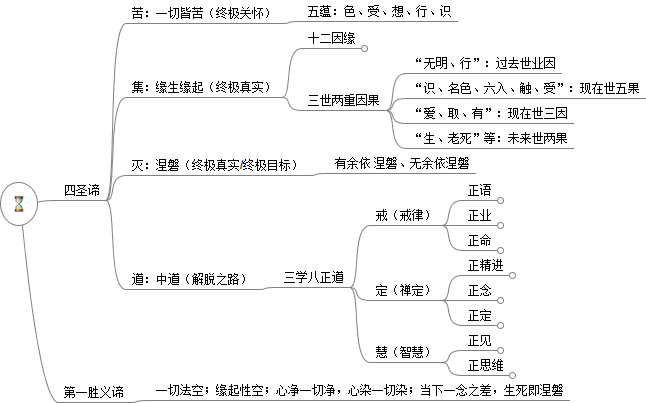佛教相关概念中英对照
根据傅伟勋《死亡的尊严与生命的尊严》——“世界宗教与死亡超克”中佛教一节,及维基页面整理的佛教相关概念与中英文对照。
四圣谛 – The Four Noble Truths
- 苦,”The noble truth that is suffering”
- 集,”The noble truth that is the arising of suffering”
- 灭,”The noble truth that is the end of suffering”
- 道,”The noble truth that is the way leading to the end of suffering”
八正道 – Noble Eightfold Path
- 慧, Prajñā is the wisdom that purifies the mind, allowing it to attain spiritual insight into the true nature of all things. It includes:
- 正见, dṛṣṭi (ditthi): viewing reality as it is, not just as it appears to be.
- 正思维, saṃkalpa (sankappa): intention of renunciation, freedom and harmlessness.
- 戒, Śīla is the ethics or morality, or abstention from unwholesome deeds. It includes:
- 正语, vāc (vāca): speaking in a truthful and non-hurtful way
- 正业, karman (kammanta): acting in a non-harmful way
- 正命, ājīvana (ājīva): a non-harmful livelihood
- 定, Samādhi is the mental discipline required to develop mastery over one’s own mind. This is done through the practice of various contemplative and meditative practices, and includes:
- 正精进, vyāyāma (vāyāma): making an effort to improve
- 正念, smṛti (sati): awareness to see things for what they are with clear consciousness, being aware of the present reality within oneself, without any craving or aversion
- 正定, samādhi (samādhi): correct meditation or concentration, explained as the first four jhānas
十二因缘 – Twelve Nidānas
- 无明, Avidyā: ignorance, specifically spiritual ignorance of the nature of reality[47]
- 行, Saṃskāras: literally formations, explained as referring to karma
- 识, Vijñāna: consciousness, specifically discriminative[48]
- 名色, Nāmarūpa: literally name and form, referring to mind and body[49]
- 六入, Ṣaḍāyatana: the six sense bases: eye, ear, nose, tongue, body and mind-organ
- 触, Sparśa: variously translated contact, impression, stimulation (by a sense object)
- 受, Vedanā: usually translated feeling: this is the “hedonic tone”, i.e. whether something is pleasant, unpleasant or neutral
- 爱, Tṛṣṇā: literally thirst, but in Buddhism nearly always used to mean craving
- 取, Upādāna: clinging or grasping; the word also means fuel, which feeds the continuing cycle of rebirth
- 有, Bhava: literally being (existence) or becoming. (The Theravada explains this as having two meanings: karma, which produces a new existence, and the existence itself.)[50]
- 生, Jāti: literally birth, but life is understood as starting at conception[51]
- 老死, Jarāmaraṇa: (old age and death) and also śokaparidevaduḥkhadaurmanasyopāyāsa (sorrow, lamentation, pain, sadness, and misery)

本来是搜索Shelly Kagan 《death》相关的东西,没想到还有这宝贝
Bonjour — 给您问个好,陌生的朋友
你好~ 真高兴对你有用。